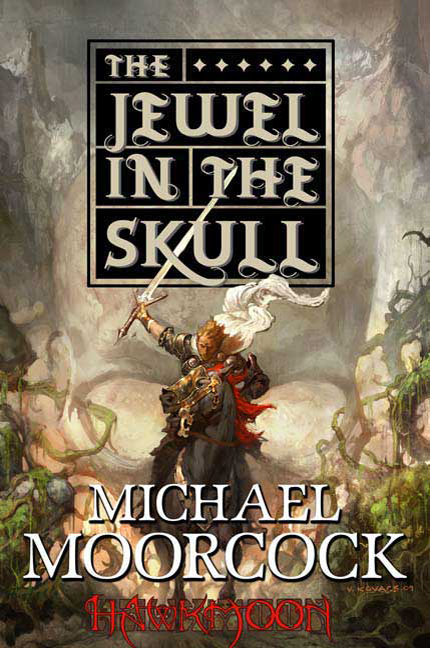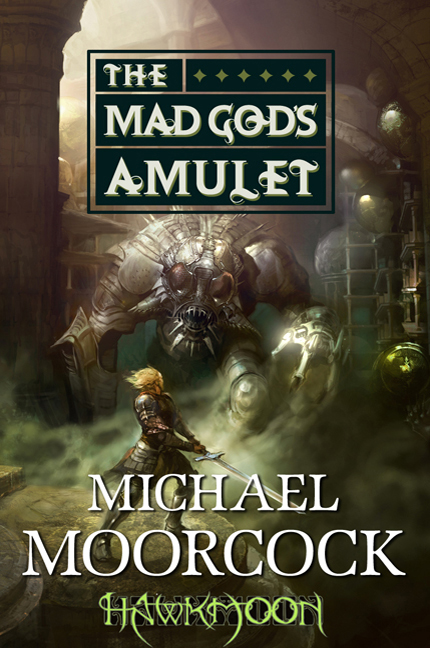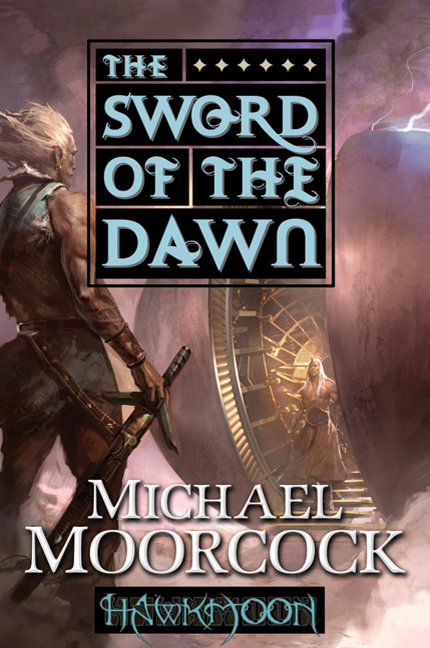
 The History of the Runestaff
The History of the Runestaff
By Michael Moorcock
The Jewel in the Skull
The Mad God’s Amulet
Sword of the Dawn
The Runestaff
by
Steven H Silver
In the 1960s, Michael Moorcock published a vast quantity of novels in a relatively short span of time. While this isn’t in and of itself unusual–other authors have had similar periods of prolificacy–Moorcock created several highly memorable, even iconic, characters during this time. At the top of the hierarchy is the moody, congenitally weakened albino Elric, but equally notable are the angst-ridden final survivor of his race Corum and the confused Erekosé, pulled from his comfortable life as John Daker. A fourth character is Duke Dorian Hawkmoon of Köln.
A rebel against the mighty and decadent Granbretan Empire, whose citizens wear ornate masks to indicate which caste they belong to, Hawkmoon is taken captive early in the four book series and sent to spy on the equally rebellious Count Brass of the Kamarg, a gemstone embedded in Hawkmoon’s forehead to ensure his loyalty to the Empire, which provides the title for the first novel, The Jewel in the Skull.
The real activity of the novel is set in motion by Baron Meliadus of Kroyden, who finds himself opposed to both Count Brass and Hawkmoon. Swearing an oath by the mystical and mythical Runestaff to destroy his enemies, Moorcock explains that such an oath can only end in one of two ways, granting Meliadus’s oath or a complete reversal, seeing Meliadus suffer the fate he wished on his enemies. From this point on, the four novels take on a feeling of predeterminism.
However, the History of the Runestaff, as the four novels are collectively called, never loses its attraction even if the ultimate conclusion has been indicated by Meliadus’s oath. Moorcock fills the books with intriguing and sensawunder-building creatures, settings, and objects as Hawkmoon meets up with various companions and foes in his travels that take him from the Kamarg to Soryandum in modern-day Iran to the city of Narleen at the base of the Mississippi River, for his world, set in the distant future Tragic Millennium, is a post apocalyptic world in which many of the great cities of today are ruins and science is studied, but also seen as a form of magic.
Although Hawkmoon’s eternal enemy is Baron Meliadus, in his journeys he comes across other, lesser foes he must face, a feature of the novels which adds depth to the idea that Grenbretan is truly a continent-spanning empire. The Frenchman D’Averc faces off with Hawkmoon in the ghost-ridden Soryandum near the end of the first novel. In The Mad God’s Amulet, a Kievan princeling stands in the way of Hawkmoon and his reunion with Yisselda, the daughter of Count Brass and Hawkmoon’s paramour. The Sword of the Dawn sees Hawkmoon traveling to the distant North American continent, far from the sway of Granbretan in order to acquire the titular magical weapon. Eventually, due to the curse and predestiny, Hawkmoon must return to Castle Brass to face off against Meliadus and the forces of Granbretan in the series’ own final battle.
The events of the novels are controlled by the Runestaff, which exerts greater and greater control over Hawkmoon and Granbretan as events move toward their inexorable conclusion, eventually making its own appearance to better orchestrate its ends. The presence of the Runestaff creates the sensation that Hawkmoon’s battle against Granbretan is something part of a larger conflict. It draws in the concepts of the Multiverse, the Cosmic Balance, and the battle between the forces of Chaos and Law which Moorcock was developing in his Elric, Corum, and Erekosë series‘. No matter how successful Hawkmoon and Count Brass might be, or whatever advantage Baron Meliadus and the Granbretanians might gain, there was more to the conflict than what those characters could see, allowing the reader the feeling that they have a better understanding of the world than the characters who inhabit it.
In many ways, Dorian Hawkmoon is a regular person who is caught in extraordinary circumstances. He lacks the eye and hand of the gods that Corum is grafted with. His body is healthy, unlike Elric of Melniboné, and he knows who he is and where he is, unlike the transported John Daker. Because of this, and despite the strange jewel grafted to his forehead, Hawkmoon is a more accessible and relatable character than the other icons Moorcock invented during this period. The reader can better connect with Hawkmoon’s trials and tribulations, whether with the evil empire or just in his attempts to spend time with his companions and fiancée.
Moorcock’s works from this period have a tendency to remain in print, or come back into print with astonishing regularity, in part because they helped lay the groundwork for so much of the sword and sorcery genre. Even authors whose main source of inspiration seems to be J.R.R. Tolkien frequently demonstrate a familiarity with Moorcock’s characters and the way they use magical items and work within the all-too-visible battle between gods. Tor’s reprinting of the History of the Runestaff brings Hawkmoon back into print to entice and entertain a new generation of fantasy readers.
The History of the Runestaff is comprised of:
The Jewel in the Skull (First published in 1967, revised by the author in 1977. Tor edition, January 2010, tpb, 222 pp., $13.99) Cover and interior illustrations by Vance Kovacs.
The Mad God’s Amulet (First published in 1968, revised by the author in 1977. Tor edition, April 2010, tpb, 207 pp., $13.99) Cover and interior illustrations by Vance Kovacs.
The Sword of the Dawn (First published in 1968, revised by the author in 1977. Tor edition, August 2010, tpb, 221 pp., $14.99) Cover and interior illustrations by Vance Kovacs.
The Runestaff (First published in 1969, revised by the author in 1977. Tor edition, forthcoming December 2010, tpb, 208 pp., $14.99) Cover and interior illustrations by Vance Kovacs.



